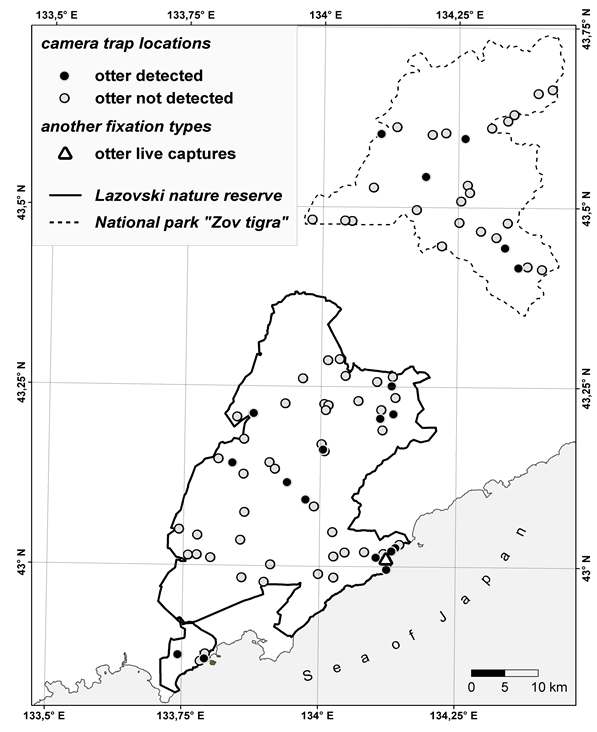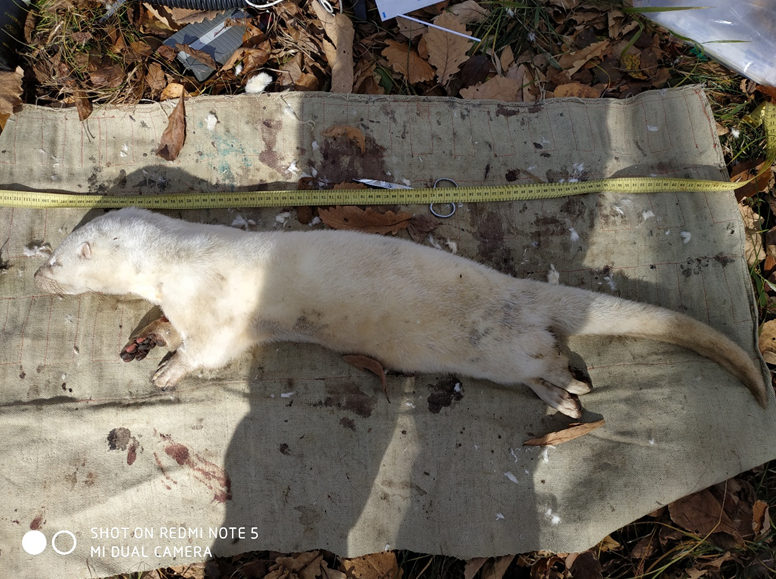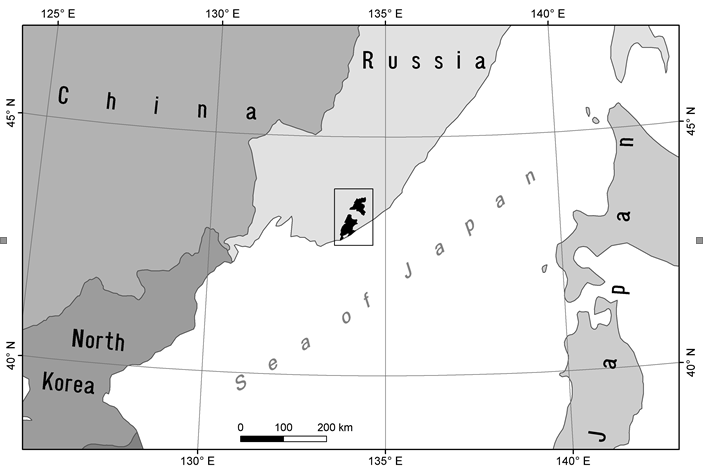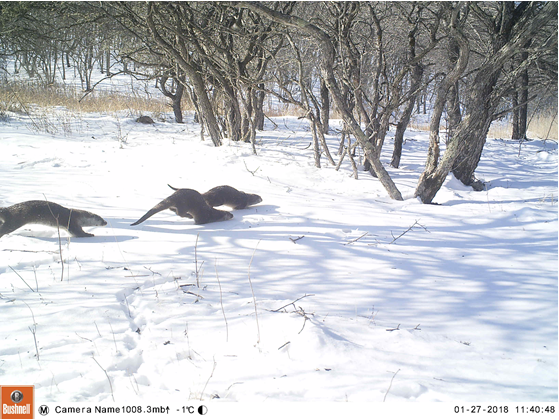IUCN/SSC Otter Specialist Group Bulletin

©IUCN/SCC Otter Specialist Group
Volume 37 Issue 3 (November 2020)
Citation: Goncharuk, MS, Voloshina, IV, Aramilev, VV, Shurygina, AA and Kerley, LL (2020). Recent Observations of Eurasian Otter Lutra lutra, including White-Coated Individuals,in the Southern Sikhote Alin, the Russian Far East. IUCN Otter Spec. Group Bull. 37 (3): 147 - 157
Recent Observations of Eurasian Otter Lutra lutra, including White-Coated Individuals,in the Southern Sikhote Alin, the Russian Far East
Mikhail S. Goncharuk1*, 2, 4, Inna V. Voloshina3, Vladimir V. Aramilev5, Anastasia A. Shurygina6, and Linda L. Kerley1*, 2, 3
1Autonomous non-commercial organization “Amur” Russian Federation, Primorsky Krai, Fokino, Karl Marks street, building 11, flat 11, postal code 692881. Email::mikhail.goncharuk@zsl.org; mikhail.goncharuk84@gmail.com
2Zoological society of London
3United Administration of Lazovsky State Nature Reserve and Zov Tigra National Park
4Primorskaya State Agricultural Academy
5The Pacific Geographical Institute of the Far Eastern Branch of the Russian Academy of Sciences
6Lomonosov Moscow State University
(Received 18th October 2019, accepted 18th February 2020)
Abstract: Eurasian otter (Lutra lutra) is a wide-ranging species with third of its range in Russia. Although Eurasian otter is categorized as “Near Threatened” with declining population by IUCN, it is also reported that Primorsky Krai is a region with high density of otter population in the Russian Far East. This study represents empirical data on otters in the south-eastern part of Primorsky Krai and updates existing status on a range map with use of by-catch camera-trapping and live trapping. Data from Lazovsky Reserve and Zov Tigra National Park archives included only white-coated individuals. During 2014-2019 Eurasian otter was camera-trapped 84 times at 18 camera-trap stations, live trapped on 2 occasions and 7 reports of white-coated individuals were obtained by The Chronicles of Nature of the Lazovsky Reserve. The spread of records geographically across the survey area and through the survey period suggests a resident, well established population in this area.Keywords: Mustelidae, range, albinism, color aberration, live trapping, camera trapping
INTRODUCTION
Eurasian otter (Lutra lutra) is a wide-ranging species with one third of its distribution in the Russian Federation where it occurs in all habitats except tundra and northern regions with permanent frost (Oleynikov and Saveljev, 2016).
Mostly solitary, this species is a semi-aquatic predator averaging in weight and body-length of 4.7 kg and 65 cm respectively, with males larger than females. Intraspecific variability is weakly expressed and in the Russian Far East the Eurasian otter’s nominative subspecies is the northern otter (L. l. lutra) (Krivosheev, 1984).
Otter fur coloration is typically dark brown on the back and lighter on the belly and throat (Krivosheev, 1984). White Eurasian otter have been observed on Sakhalin Island (Vshivtsev, 1972) and also reported as news articles from Northern Europe (Ring, 2016; Fairnie, 2019), but to our knowledge, never reported in the continental part of Russian Far East.
Although the Eurasian otter is classified as “Near Threatened” in the IUCN Red List with a declining population (Roos et al., 2015), Oleynikov and Saveljev (2016) reported Primorsky Krai as a region with relatively high otter numbers in the Russian Far East. However, population numbers and status remain unknown because surveys have not been conducted consistently.
This study represents empirical date on Eurasian otters in the south-eastern part of Primorsky Krai by use of by-catch camera-trapping and live trapping. We also document the species recent occurrence with normal and white color morphs to verify the species continuous existence in area.
ANIMALS, MATERIAL AND METHODS
Lazovsky Reserve (1,240 km² in size) and Zov Tigra National Park (870 km²) are protected areas located in south-eastern Primorsky Krai, in the temperate Ussuri broadleaf and mixed forest ecoregion (Laptev et. al, 1995) (Figure 1). The region experiences warm summers (averaging 17.4 °C near the coast of the Sea of Japan and 23.5 °C further inland), and cold winters (averaging -10.4 °C near the coast of the Sea of Japan to -30 °C further inland) (Laptev et. al, 1995), but local climate varies significantly even within Lazovsky Reserve, reflecting distance to the sea. Areas near the sea are generally cooler in summer and warmer in winter, with typically less deep winter snow.
Records on otter distribution were obtained using two methods:1) by-catch in camera traps set for Amur tigers (Kerley and Borisenko, 2010, 2013) and 2) live captures during disease monitoring (Goncharuk et al., 2012). Supplementary information on white coloration was obtained from records in United Administration of Lazovsky State Nature Reserve and Zov Tigra National Park archives.
A research study on Amur tigers (Panthera tigris) in the Russian Far East (Kerley and Borisenko, 2010, 2013) established a network of 86 unbaited camera-trap stations (Bushnell Trophy Cam digital camera-traps, Bushnell Co, Overland Park, KS, USA) throughout Lazovsky Reserve and Zov Tigra National Park giving an effective survey area of approximately 2,800 km². Camera-traps stations were spaced no more than 10 km apart on forest roads and trails in places frequented by tigers. Each camera-trap was attached to a tree approximately 45-60 cm from the ground, set to 24 hours operation. The same stations were used throughout the study period of January 2014 to June 2019. Notionally independent records of otter were defined as those photographs taken at least 24 hours apart from others at the same camera-trap station (Kerley and Borisenko, 2013).
Live trapping was conducted in April-June and October-November with use of live animal traps made from wire mesh (Havahart traps, Woodstream Corp., United States) and home-made cages. Fresh fish was used as bait. Live-traps were placed every 250 m along roads, pathways and creeks and were monitored daily. After capture and anesthesia all animals were released back into the wild (Goncharuk et al., 2012). Alpha-2 adrenergic receptor agonist - dexmedetomidine hydrochloride 0,05% (Dexdomitor 0,5mg/ml,”Orion Corporation”, Orionintie 1, FI-02200 Espoo, Finland) was used in dosage of 60 mcg per kilogram of body weight for otter sedation with use of isoflurane (Forane, Abbott, USA) as supportive drug for anesthesia maintenance. Dexmedetomidine delivery was performed with hand intramuscular injection by syringe to the hip or shoulder. After the initial injection of dexmedetomidine anesthesia was prolonged with isoflurane. Delivery of isoflurane was performed with use of “Isuflurane and air anesthetic equipment” (International Zoo Veterinary Group, Keighley Business Centre, South Street, Keighley, West Yorkshire BD21 1AG, United Kingdom) (Lewis, 2004). Atipamezole hydrochloride 0,5% (Antisedan, ”Orion Corporation”, Orionintie 1, FI-02200 Espoo, Finland) was used as a reversal drug in dosage of 10 mg of atipamezole per 1 mg of dexmedetomidine. During recovery, immobilized animals were monitored by us from a distance until they regained consciousness and were able to leave the area on their own accord. Live trapping of non-red book species on the territory of protected area (Lazovsky Reserve in our case) with further release back to the wild does not need special permission besides of approved "Plan of scientific work" which was obtained in due time.
RESULTS
Camera traps
During 39,600 camera-trap days, normal colored otters were recorded as by-catch in tiger habitat 84 times at 18 camera-trap locations and no white individuals were recorded (Fig. 2, Table 1). Animals were mostly nocturnal with only 11 daylight photographs recorded. Records came from an elevation range of 8 - 639 m and mostly near rivers, streams and along the Sea of Japan shoreline. Otter were often photographed alone or, less often, in family groups of two (n=9) and three (n=3; Fig. 3) individuals.

Live-traps
During 6,400 cage-trap days two otters were captured; one white and one normal colored individuals (Table 1, 2). The white-coated otter (captured on 29 October 2018) was determined to be a partial albino due to the absence of pigmentation in its iris (e.g. it had red eyes), but pigmentation in paws and nose had been retained (Fig. 4, 5). This female weighed 4.5 kg and had the following body measurements: body length = 59.5cm; tail length = 35 cm; head length = 12.5cm; front leg length (from humeral joint to distal finger phalanx edge) = 14 cm; hind leg length (from hip joint to distal finger phalanx edge) = 20.5 cm; front paw pad width = 3.2 cm; hind paw pad width = 3.2 cm; and chest circumference = 27.5 cm.

A normal colored female was captured on 5 May 2018, weighing 4.5 kg and had the following body measurements: body length = 59 cm; tail length = 34.5 cm; head length = 14.5 cm; front limb length (from humeral joint to distal finger phalanx edge) = 16 cm; hind limb length (from hip joint to distal finger phalanx edge) = 24.5 cm; front paw pad width = 2.9 cm; hind paw pad width = 2.7 cm; and chest circumference = 27 cm.
Between 1980 and 2018, seven white otters were recorded in the Lazovsky Reserve’s Chronical of Nature Archives (Table 2). Four were observed on the protected area, two were captured during fur trapping season outside of protected area and one was killed also outside of protected area by a hunter who donated the skin to the reserve.
DISCUSSION
The habitat of the tiger and otter are significantly different. An otter, unlike a tiger, is a semi-aquatic predator closely connected with river valleys, streams and the sea coast. Since camera-traps were set specifically to photograph tigers and not otter, results represent a minimum number of otters in the area and not an estimate of population size. None-the-less, the spread of records geographically across the survey area and through the survey period suggests a resident population well established in this area, including rare white coated individuals. This is consistent with Oleynikov and Saveljev (2016).
Albinism can be defined in several different ways, but there are a few distinctive types of albinism depending on certain defining characteristics. True or complete albinism is the total absence of integumentary and retinal pigmentation (Sandoval-Castillo et al., 2006). Partial albinism occurs when pigment is reduced or absent from the skin, feathers, or eyes (Berdeen and Otis, 2011). Leucism or leukism is a form of partial albinism characterized by retention of color in the eyes, bill, and legs but the skin or plumage contains no color pigment (Forrest and Naveen, 2000). There are discrepancies in these definitions depending on the time of publication and the author. Some older articles have defined albino as an animal with any lack of pigment on the body, while others use the term leucistic for what should, by these definitions, be termed partial (Jehl, 1985; Owen and Shimmings, 1992; Castillo-Geurrero et al., 2005). In our case, the live-trapped white otter did not have pigmentation in the eyes (Fig.5), but pigmentation on the nose and paws had been retained, thus we inclined to think that it was manifestation of partial albinism. Because we had no information on eye pigment for other observations reported here, it is unclear if those white coated otters were true albinos, partial albinos or leucistic animals.
Although aberrantly pale individuals have been recorded in other species of Lutrinae subfamily (Procter, 1963; Lariviere, 2002; Costa Toledo et al., 2014), this study represents the first record of partial albinism in Eurasian otter on the mainland Russian Far East and confirms the presence of corresponding genes (Summers, 2009) in the population in Southern Sikhote Alin mountain range.
Acknowledgements: We thank Dr. Alexander I. Myslenkov of United Administrations of Lazovsky Reserve and Zov Tigra National Park for logistical support. Dorothy Howard Charitable Trust, WildCats Conservation Alliance and the Indianapolis Zoo provided for financial support. We also thank student volunteers Daniil Romantsov, Dmitry Moskaletst and Nikita Perepelitsa from Primorskaya State Agricultural Academy and veterinary volunteer Irina Sturunina for gratuitous assistance in mesocarnivore live trapping.
REFERENCES
Berdeen, J. B., Otis. D. L. (2011). An observation of a partially albinistic Zenaida macroura (mourning dove). Southeastern Naturalist 10: 185-188.
Castillo-Geurrero, J., Mellink, E., Penaloza-Padilla, E., Pradolopez, M. (2005). Anomalously pigmented brown boobies in the Gulf of California: leucism and possibly hybridization with the blue-footed booby. Western Birds 36: 325-328.
Costa Toledo, G.A., Filho N.M.G., Zermiani, F.C., Azevodo J.C.N., Feijo, A. (2014) Albinism in neotropical otter, Lontra longicaudis (Carnivora: Mustelidae) Pan-American Journal of Aquatic Sciences, 9: 234-238
Fairnie, R. (2019). Extremely rare albino otter spotted by stunned Livingston man at country park in West Lothian. Edinburgh live website. https://www.edinburghlive.co.uk/news/edinburgh-news/extremely-rare-albino-otter-spotted-16032927 [accessed 23/12/20]
Forrest, S.C., Naveen, R. (2000). Prevalence of leucism in pygocelid penguins of the Antarctic peninsula. Waterbirds 23: 283-285.
Goncharuk, M.S., Kerley, L.L., Naidenko, S.V., Rozhnov, V.V. (2012). Prevalence of Seropositivity to Pathogens in Small Carnivores in Adjacent Areas of Lazovskii Reserve Biology Bulletin. 39: 708–713.
Jehl, J., (1985). Leucism in eared grebes in Western North America. Condor 87: 439-441.
Kerley, L.L., Borisenko, M.E. (2010) .Amur tiger investigations by camera-traps in Lazovsky Reserve and adjacent areas. pp. 110-119. In Myslenkov, A., Voloshina I., Kerley, L. (eds) Proceedings of the scientific conference, devoted to the 75 anniversary of Lazovsky reserve. Lazo, September 28-29, 2010. Russkij Ostrov, Vladivostok, Russia. [In Russian and English].
Kerley, L.L., Borisenko, M.M. (2013). New locations for the Leopard Cat in the Russian Far East. Cat News. 59: 20-21.
Krivosheev, V.G. (1984). A guide to terrestrial mammals of the Far East USSR. Nauka, Moscow, USSR. [in Russian]
Laptev, A.A., Makovkin, L.E., Medvedev, V.N., Salkina, G.P., Sundukov, Y.N. (1995). Inventory of Terrestrial Vertebrates of Lazovsky Reserve (Russian Far East). An annotated species list. Dalnauka, Vladivostok, Russian Federation. (In Russian).
Lariviere, S. (2002). Lutra macullicolis. Mammalian Species 712: 1-6
Lewis, J.C.M., (2004). Field use of Isoflurane and air anesthetic equipment in wildlife. Journal of Zoo and Wildlife Medicine. 35(3): 303–311
Oleynikov, A.Yu., Saveljev, A.P. (2016). Current distribution and population status of the Eurasian otter (Lutra lutra) in Russia and some adjacent countries – a review. IUCN Otter Spec. Group Bull. 33(A): 21-30.
Owen, M., Shimmings., P. (1992). The occurrence and performance of leucistic barnacle geese, Branta leucopsis. Ibis 134(1):22-26.
Procter, J. (1963). A contribution to the natural history of the Spotted-necked otter (Lutra maculicollis lichtenstein) in Tanganyika. African Journal of Ecology 1(1): 93-102
Ring, H. (2016). National Geographic website https://blog.nationalgeographic.org/2016/07/29/albino-otter-proves-to-be-as-adorable-as-youd-hope/
Roos, A., Loy, A., de Silva, P., Hajkova, P., Zemanova, B. (2015). Lutra lutra. The IUCN Red List of Threatened Species 2015: e.T12419A21935287. http://dx.doi.org/10.2305/IUCN.UK.2015-2.RLTS.T12419A21935287.en [accessed 23/12/20]
Sandoval-Castillo, J., Mariano-Melendes, E., Villavicencio-Garayzar, C. 2006. New records of albinism in two elasmobranchs: the tiger shark (Galeocerdo cuvier) and the giant electric ray (Narcine entemedor). Cybium. 30(2):191-192.
Summers, C. (2009). Albinism: classification, clinical characteristics, and recent findings. Optometry and vision science: Official publication of the American Academy of Optometry. 86: 659-62. https://doi.org/10.1097/opx.0b013e3181a5254c [accessed 23/12/20]
Vshivtsev, V.P. (1972). Otter of Sakhalin. Nauka, Novosibirsk, 108 p. (In Russian)
Résumé: AObservations Recentes de la Loutre Eurasienne, Lutra Lutra, incluant des Individus à Pelage Blanc, dans le Sud Sikhote Alin, l’Extreme Orient Russe
La loutre eurasienne (Lutra lutra) est une espèce dont l’aire de répartition est très étendue dont un tiers se trouve en Russie. Bien que la loutre eurasienne soit classée par l'IUCN comme espèce «quasi menacée» avec une population en déclin, il est également rapporté que le Primorsky Kraï est une région à forte densité de population de loutre dans l’Extrême-Orient russe. Cette étude présente des données empiriques sur les loutres dans le Sud-Est du Primorsky Krai et réactualise le statut existant de la carte de répartition en utilisant des pièges photos et le piègeage vivant. Les données des archives de la Réserve de Lazovsky et du Parc National de Zov Tigra ne comprenaient que des individus à pelage blanc. Au cours de la période 2014-2019, la loutre eurasienne a été photographiée à 84 reprises par 18 pièges photos, capturée vivante à 2 reprises et 7 données d'individus à pelage blanc ont été retrouvées dans Les Chroniques de la Nature de la Réserve Lazovsky. La répartition géographique des enregistrements dans la zone d'étude et durant la période du suivi suggère une population résidente bien établie dans cette aire.
Revenez au dessus
Resumen: Observaciones Recientes de Nutria Eurasiática Lutra lutra incluyedo Individuos de Pelaje Blanco, en el Sikhote Alin Meridional, Extremo Oriente de Rusia
La nutria eurasiática (Lutra lutra) es una especie de amplia distribución, estando un tercio de su rango geográfico en Rusia. Aunque está categorizada por la UICN como “Casi Amenazada” y con población declinante, también se ha informado que Primorsky Krai es una región con alta densidad poblacional de nutrias en el extremo oriental de Rusia. Este estudio presenta datos empíricos sobre las nutrias en la parte sud-oriental de primorsky Krai, y actualiza el status en un mapa de distribución, en base a cámaras-trampa y captura viva. Los datos de los archivos de la Reserva Lazovsky y el Parque Nacional Zov Tigra incluyeron solamente individuos de pelaje blanco. Durante 2014-2019 la nutria eurasiática fue foto-trampeada 84 veces en 18 estaciones de cámaras-trampa, capturada viva en 2 ocasiones, y se obtuvieron 7 reportes de individuos de pelaje blanco en la crónicas naturales de la Reserva Lazovsky. La dispersión de los registros a través de toda el área relevada y todo a lo largo del período examinado sugieren una población residente y bien establecida en este área.
Vuelva a la tapa
РЕФЕРАТ: НАБЛЮДЕНИЯ ПО ЕВРАЗИЙСКОЙ ВЫДРЕ Lutra lutra, ВКЛЮЧАЯ ОСОБЕЙ БЕЛОГО ОКРАСА, НА ЮЖНОМ СИХОТЕ-АЛИНЕ, ДАЛЬНИЙ ВОСТОК РОССИИ
Евразийская выдра (Lutra lutra) является широко распространённым видом, где одна треть его ареала приходится на территорию России. Хотя МСОП категоризирует выдру, как близкий к уязвимому положению вид со снижающейся численностью популяции, так же сообщается, что Приморский край является регионом с высокой плотностью популяции выдры на Дальнем Востоке России. Данная статья представляет собой набор эмпирических данных по выдре в юго-восточной части Приморского края и дополняет уже существующий статус на карте ареала с использованием живоотлова и попутных данных с фотоловушек. Данные из архивов Лазовского заповедника и национального парка «Зов тигра» включили в себя только особей белого окраса. В период 2014-2019 Евразийская выдра была зарегистрирована на фотоловушках 84 раза на 18-ти стационарах, в 2-х случаях отловлена живой, и данные о 7 случаях белого окраса у выдры были взяты из томов Летописи Природы Лазовского заповедника. Географическое распределение данных на исследуемой территории за данный период исследования предполагает наличие резидентной, хорошо зарекомендовавшей себя популяции в этом районе.
Вернуться наверх



